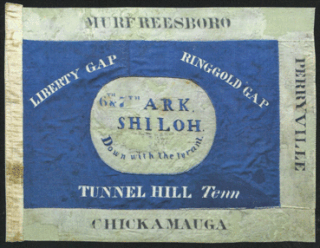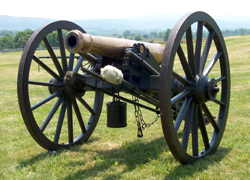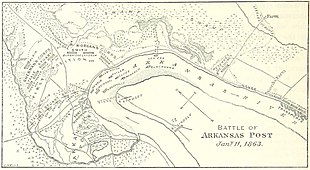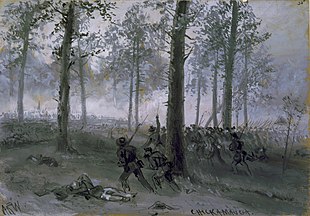
The Battle of Ringgold Gap was fought November 27, 1863, outside the town of Ringgold, Georgia, by the Confederate and Union armies during the American Civil War. Part of the Chattanooga Campaign, it followed a heavy Confederate loss at the Battle of Missionary Ridge from which General Braxton Bragg's artillery and wagon trains were forced to retreat south. The five hour Battle of Ringgold Gap resulted in the Confederate victory of Major General Patrick R. Cleburne and gave the Army of Tennessee safe passage to retreat through the Ringgold Gap mountain pass.

Walker's Greyhounds was the popular name for a division of the Confederate States Army under Major-General John George Walker, composed exclusively of units from Texas. It fought in the Western Theater and the Trans-Mississippi Department, gaining its nickname because the men were able to move long distances rapidly on foot.

Hiram Bronson Granbury was a lawyer and county judge in Texas before the American Civil War. He organized a volunteer company for the Confederate States Army after the outbreak of the Civil War and became its captain. He rose to the grade of brigadier general in the Confederate army. Granbury was one of the six Confederate generals killed at the Battle of Franklin on November 30, 1864.

The 7th Arkansas Volunteer Infantry (1861−1865) was a Confederate Army infantry regiment during the American Civil War. Organized mainly from companies, including several prewar volunteer militia companies, raised in northeastern Arkansas, the regiment was among the first transferred to Confederate service, and spent virtually the entire war serving east of the Mississippi River. After the unit sustained heavy casualties in the Battle of Shiloh and the Kentucky Campaign, the unit spent most of the rest of the war field consolidated with the 6th Arkansas Infantry Regiment to form the 6th/7th Arkansas Infantry Regiment.
The 15th Arkansas Infantry Regiment or Josey's Arkansas Infantry Regiment was an infantry formation in the Confederate States Army during the American Civil War. The regiment was organized in May 1861 under the command of Colonel Patrick Cleburne. It served throughout the war in the western theater, seeing action in the Kentucky, Tennessee, and Georgia campaigns. Following its depletion in numbers the regiment was consolidated several times with other Arkansas regiments, finally merging in 1865 into the 1st Arkansas Consolidated Infantry Regiment. There were two other regiments which also received the designation of "15th Arkansas". The 21st (McRae's) Arkansas Infantry was redesignated 15th Arkansas in February 1863, but to avoid confusion, was normally referred to as the 15th (Northwest) Arkansas Infantry Regiment. This second "15th Arkansas" was surrendered at Vicksburg in July 1863. A third regiment, under command of Colonels Gee and later Johnson, also received the designation 15th Arkansas Infantry. This last regiment surrendered at Port Hudson, Louisiana, in July 1863.

The 6th Texas Infantry Regiment was an infantry regiment from Texas that served in the Confederate States Army in the American Civil War. The regiment fought in the Battles of Arkansas Post, Chickamauga and Missionary Ridge.
The 24th Arkansas Infantry (1861–1865) was a Confederate Army infantry regiment during the American Civil War. The unit began its service in the Department of the Trans-Mississippi, but the bulk of the unit was captured at the Battle of Arkansas Post and shipped to Northern prison camps. The unit was exchanged in Virginia and shipped to Tennessee and joined the Army of Tennessee in time for the Chattanooga Campaign and remained with the army through the Atlanta Campaign, the Franklin-Nashville Campaign and ended the war in North Carolina.

The 9th Texas Cavalry Regiment was a unit of mounted volunteers that fought in the Confederate States Army during the American Civil War. The regiment fought at Round Mountain and Bird Creek (Chusto-Talasah) in 1861, Pea Ridge, Siege of Corinth, Second Corinth, Hatchie's Bridge and the Holly Springs Raid in 1862, and in the Atlanta campaign, Franklin, and Murfreesboro in 1864. The unit fought dismounted at Second Corinth and Hatchie's Bridge before being remounted as cavalry for the remainder of the war. The regiment surrendered to Federal forces on 4 May 1865 and its remaining personnel were paroled.

The 7th Texas Infantry Regiment was a unit of Confederate States Army infantry volunteers organized in 1861 that fought mostly in the Army of Tennessee during the American Civil War. The regiment was captured at Fort Donelson in 1862 and sent to Northern prison camps. After the survivors were exchanged and new recruits added, the regiment was reconstituted and fought at Raymond, Jackson, Chickamauga, Missionary Ridge, and Ringgold Gap in 1863. The unit served in the Atlanta Campaign and at Franklin, Nashville, Averasborough, and Bentonville in 1864–1865. The regiment's 65 survivors surrendered to William Tecumseh Sherman's Federal forces on 26 April 1865.

The 9th Texas Infantry Regiment was a unit of Confederate States Army infantry volunteers organized in December 1861 that fought during the American Civil War. The regiment fought at Shiloh, Perryville, and Stones River in 1862, Chickamauga in 1863, the Atlanta Campaign, Allatoona, and Nashville in 1864, and Spanish Fort and Fort Blakeley in 1865. The remaining 87 officers and men surrendered to Federal forces in May 1865. Two of the regiment's commanding officers were promoted brigadier general.

The 10th Texas Infantry Regiment was a unit of Confederate States Army infantry volunteers organized in October 1861 that fought during the American Civil War. The regiment was captured in its first major action at Arkansas Post in January 1863. After being exchanged three months later, the 10th Texas was consolidated with two other regiments and assigned to Patrick Cleburne's division. Subsequently, the consolidated regiment fought at Chickamauga, Missionary Ridge, and Ringgold Gap in 1863. After becoming an independent regiment again, the 10th Texas fought in the Atlanta Campaign, and at Franklin and Nashville in 1864. After a second consolidation the troops fought at Averasborough and Bentonville in 1865. The regiment's soldiers surrendered to Federal forces on 26 April 1865.

The 32nd Texas Cavalry Regiment, sometimes incorrectly named Andrews's 15th Texas Cavalry Regiment, was a unit of volunteer cavalry mustered into the Confederate States Army in May 1862 and which fought during the American Civil War. The regiment was formed around companies from Richard Phillip Crump's 1st Texas Cavalry Battalion which fought in Indian Territory and at Pea Ridge. Many of the soldiers died of disease in the unhealthy camps near Corinth, Mississippi. The cavalrymen were dismounted in July 1862 and served as infantry for the rest of the war. The regiment fought at Richmond, Ky., Stones River, and Chickamauga in 1862–1863, in the Meridian and Atlanta campaigns and at Nashville in 1864, and at Spanish Fort and Fort Blakeley in 1865. The regiment's 58 surviving members surrendered to Federal forces on 9 May 1865.

Douglas's Texas Battery was an artillery battery that served in the Confederate States Army during the American Civil War. In June 1861, the unit was formed by combining one group of men from Dallas with a second group from Tyler and placing them under the command of John Jay Good. The battery fought at Pea Ridge in March 1862 and soon afterward transferred to the east side of the Mississippi River. James Postell Douglas replaced Good as commander and led the battery at Richmond, Stones River, Chickamauga, Chattanooga, the Atlanta Campaign, Franklin, and Nashville. After operations around Mobile, Alabama, Confederate units in the region surrendered and the survivors of the battery were paroled on 12 May 1865. It was the only Texas field artillery unit that served east of the Mississippi.

The 3rd Texas Cavalry Regiment or South Kansas-Texas Mounted Volunteers was a unit of mounted volunteers that fought in the Confederate States Army during the American Civil War. The regiment fought at Wilson's Creek and Chustenahlah in 1861, Pea Ridge, Corinth siege, Iuka, Second Corinth, and the Holly Springs Raid in 1862, Thompson's Station in 1863, and at Yazoo City, in the Atlanta campaign, and at Nashville in 1864. The regiment fought dismounted at Iuka and Second Corinth before being remounted for the rest of the war. The regiment surrendered to Federal forces in May 1865 and its remaining 207 men were paroled.

The 27th Texas Cavalry Regiment, at times also known as Whitfield's Legion or 1st Texas Legion or 4th Texas Cavalry Battalion, was a unit of mounted volunteers that fought in the Confederate States Army during the American Civil War. First organized as the 4th Texas Cavalry Battalion or Whitfield's Legion, the unit served dismounted at Pea Ridge and First Corinth. Additional companies from Texas were added and the unit was upgraded to the 27th Texas Cavalry Regiment or 1st Texas Legion later in 1862. Still dismounted, the unit fought at Iuka and Second Corinth. The regiment was remounted and fought at Holly Springs in 1862, Thompson's Station in 1863, and at Yazoo City, Atlanta, Franklin, and Third Murfreesboro in 1864. The regiment surrendered to Federal forces in May 1865 and its remaining soldiers were paroled.

The 3rd Louisiana Infantry Regiment was a unit of foot soldiers from Louisiana that fought in the Confederate States Army during the American Civil War. The regiment distinguished itself at Wilson's Creek in 1861. The 3rd Louisiana fought at Pea Ridge, First Corinth, Iuka, and Second Corinth in 1862. The unit defended Vicksburg in 1863 where it was captured. At Vicksburg, the unit's fortification was twice blown up by powerful land mines. The surviving soldiers were paroled and exchanged, after which they performed guard duty for the rest of the war.

The 6th Texas Cavalry Regiment was a unit of mounted volunteers that fought in the Confederate States Army during the American Civil War. The regiment fought at Chustenahlah in 1861. The following year the unit fought at Pea Ridge, First Corinth, Second Corinth, Hatchie's Bridge, and Holly Springs. The 6th Texas Cavalry participated in the fighting at Thompson's Station in 1863, the Atlanta campaign, and the Franklin–Nashville Campaign in 1864. The regiment formally surrendered to Union forces in May 1865 and its remaining soldiers were paroled.

The 24th and 25th Consolidated Texas Cavalry Regiment was a unit that originally consisted of two regiments of mounted volunteers that served in the Confederate States Army during the American Civil War. However, by the time the two regiments were consolidated, they fought as infantry. Both regiments organized as cavalry near Hempstead, Texas in April 1862 and were dismounted to fight as infantry in July 1862. The two regiments served in the same brigade and were captured at the Battle of Arkansas Post in January 1863. After being sent to Northern prison camps, the soldiers were exchanged in April 1863. Assigned to the Army of Tennessee, the two regiments were consolidated with two additional Texas cavalry regiments and in 1863 fought as infantry at Liberty Gap, Chickamauga, Missionary Ridge, and Ringgold Gap. In 1864, the other two Texas regiments were detached and the consolidated 24th and 25th fought as a separate infantry unit in the Atlanta campaign, at Franklin, and at Nashville. For the Carolinas campaign, the 24th and 25th fought at Bentonville before being reconsolidated with other Texas regiments and surrendering in April 1865.

The 28th Texas Cavalry Regiment was a unit of mounted volunteers recruited in east Texas that fought in the Confederate States Army during the American Civil War. In May 1862, the regiment entered Confederate service and served the entire war west of the Mississippi River in the region known as the Trans-Mississippi Department. The unit was soon dismounted before being assigned to the 2nd Brigade of the all-Texas infantry division known as Walker's Greyhounds. In 1863, the regiment played a secondary role at Milliken's Bend. The regiment fought in three major battles during April 1864, at Mansfield, Pleasant Hill, and Jenkins' Ferry. The Trans-Mississippi Department surrendered on 26 May 1865, but the survivors dispersed to their homes before that date.

The 20th Louisiana Infantry Regiment was a unit of volunteers recruited in Louisiana that fought in the Confederate States Army during the American Civil War. The unit began its existence as the 6th Louisiana Battalion in September 1861. The battalion was augmented to regimental strength in January 1862 at New Orleans and served during the war in the Western Theater of the American Civil War. The regiment fought at Shiloh, Farmington, and Perryville in 1862. After being reduced in numbers, the regiment was consolidated with the 13th Louisiana Infantry Regiment and served at Stones River, Jackson, Chickamauga, and Missionary Ridge in 1863. The 13th-20th Consolidated Louisiana fought at Resaca, New Hope Church, Ezra Church, and Nashville in 1864. The consolidation with the 13th Louisiana was discontinued in February 1865 and the regiment was re-consolidated with other units. It fought its final battle at Spanish Fort one month before surrendering in May 1865.




















